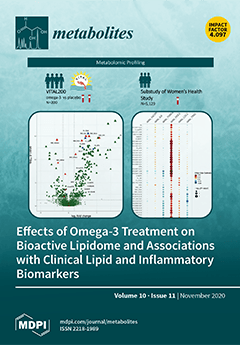Pathogenic microorganisms account for large production losses in the agricultural sector.
Phytophthora capsici is an oomycete that causes blight and fruit rot in important crops, especially those in the Solanaceae family.
P. capsici infection is difficult to control due to genetic diversity, arising
[...] Read more.
Pathogenic microorganisms account for large production losses in the agricultural sector.
Phytophthora capsici is an oomycete that causes blight and fruit rot in important crops, especially those in the Solanaceae family.
P. capsici infection is difficult to control due to genetic diversity, arising from sexual reproduction, and resistant spores that remain dormant in soil. In this study, the metabolomics of tomato plants responding to infection by
P. capsici were investigated. Non-targeted metabolomics, based on liquid chromatography coupled to mass spectrometry (LC-MS), were used with multivariate data analyses to investigate time-dependent metabolic reprogramming in the roots, stems, and leaves of stem-infected plants, over an 8 day period. In addition, phytohormones and amino acids were determined using quantitative LC-MS. Methyl salicylate and 1-aminocyclopropane-1-carboxylate were detected as major signalling molecules in the defensive response to
P. capsici. As aromatic amino acid precursors of secondary metabolic pathways, both phenylalanine and tryptophan showed a continuous increase over time in all tissues, whereas tyrosine peaked at day 4. Non-targeted metabolomic analysis revealed phenylpropanoids, benzoic acids, glycoalkaloids, flavonoids, amino acids, organic acids, and fatty acids as the major classes of reprogrammed metabolites. Correlation analysis showed that metabolites derived from the same pathway, or synthesised by different pathways, could either have a positive or negative correlation. Furthermore, roots, stems, and leaves showed contrasting time-dependent metabolic reprogramming, possibly related to the biotrophic vs. necrotrophic life-stages of the pathogen, and overlapping biotic and abiotic stress signaling. As such, the targeted and untargeted approaches complemented each other, to provide a detailed view of key time-dependent metabolic changes, occurring in both the asymptomatic and symptomatic stages of infection.
Full article






